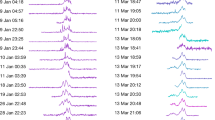Abstract
MOST extra-galactic radio sources have a spectrum which over a limited frequency range is of the form Sαν−α, where S is the flux density and ν is the frequency. The spectral index α is usually constant over a considerable frequency range, which implies a straight spectrum when plotted logarithmically, the average value over all sources being 0.75 with a range from about 0.2 to 1.3. For some sources, however, α changes slowly with frequency with the result that the spectra are concave or convex1–3. It is believed that the radiation is produced by the synchrotron mechanism, where energy losses by the electrons can lead in time to an increase in the slope4,5 and where, in addition, different component sources may contribute to the overall spectrum. High frequency observations by Dent and Haddock6 showed that two sources, 3C 84 (NGC 1275, a Seyfert galaxy) and 3C 279 (a quasi-stellar source), have spectra which decrease in flux density from about 38 MHz towards higher frequencies, but beyond 3,000 MHz the slope of the spectrum is positive. This suggested the presence of a small diameter component which had a low frequency cut-off due to synchrotron self-absorption7 and stimulated a search for other sources with similar spectra. Kellermann (personal communication) has recently observed fourteen sources with irregular spectra, of which some have a tendency towards these latter characteristics, but so far there have been no published spectra similar to 3C 84 and 3C 279. Recent observations at the frequencies of 3,200, 6,600 and 10,600 MHz, however, using the 150 foot telescope of the Algonquin Radio Observatory, when combined with the observations by other observers8–11, have shown that the source 4C 50.11/NRAO 150 is of this form but with the addition of two apparent peaks at frequencies of about 350 and 9,000 MHz. The source is included in the list by Kellermann, but details of the characteristics failed to show up because of the omission of low frequency observations and the new measurements between 5,000 and 15,000 MHz.
This is a preview of subscription content, access via your institution
Access options
Subscribe to this journal
Receive 51 print issues and online access
$199.00 per year
only $3.90 per issue
Buy this article
- Purchase on Springer Link
- Instant access to full article PDF
Prices may be subject to local taxes which are calculated during checkout
Similar content being viewed by others
References
Conway, R. C., Kellermann, K. I., and Long, R. J., Mon. Not. Roy. Astro. Soc., 125, 261 (1963).
Kellermann, K. I., Ap. J., 140, 969 (1964).
Dent, W. A., and Haddock, F. T., Ap. J., 144, 568 (1966).
Kardashev, N. S., Sov. Ast. A-J., 8, 217 (1962).
Kellermann, K. I., Ap. J., 146, 621 (1966).
Dent, W. A., and Haddock, F. T., Nature, 205, 487 (1965).
Slish, V. I., Nature, 199, 682 (1963).
Williams, P. J. S., Kenderdine, S., and Baldwin, J. E., Mem. Roy. Astro. Soc., 70, 53 (1966).
Gower, J. F. R., Scott, P. F., and Wills, D., Mem. Roy. Astro. Soc., 71, 49 (1967).
Howard, W. E., and Moran, S. P., Ap. J. Suppl., 10, 1 (1965).
Pauliny-Toth, I. I. K., Wade, C. M., and Heeschen, D. S., Ap. J. Suppl., 13, 65 (1966).
Palmer, H. P., Rowson, B., Anderson, B., Donaldson, W., Miley, G. K., Gent, H., Adgie, R. L., Slee, O. B., and Crowther, J. H., Nature, 213, 789 (1967).
Ryle, M., and Longair, M. S., Mon. Not. Roy. Astro. Soc., 136, 123 (1967).
Author information
Authors and Affiliations
Rights and permissions
About this article
Cite this article
HUGHES, V., POTTER, R. Spectrum of the Radio Source 4C 50.11/NRAO 150. Nature 217, 832–833 (1968). https://doi.org/10.1038/217832a0
Received:
Issue Date:
DOI: https://doi.org/10.1038/217832a0
This article is cited by
-
Radio Observations of Pre-protostars
Nature (1969)
-
Спектр и поляризация источника синхротронного излучения при релятивистском разлете его компонент
Astrophysics and Space Science (1969)
-
The spectrum and polarization of a source of synchrotron emission with components flying apart at relativistic velocities
Astrophysics and Space Science (1969)
Comments
By submitting a comment you agree to abide by our Terms and Community Guidelines. If you find something abusive or that does not comply with our terms or guidelines please flag it as inappropriate.



